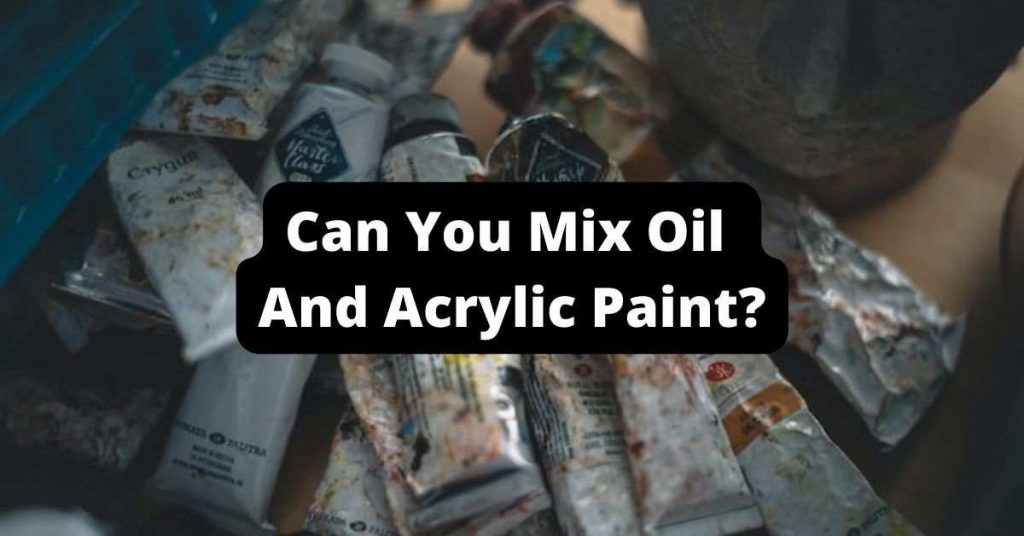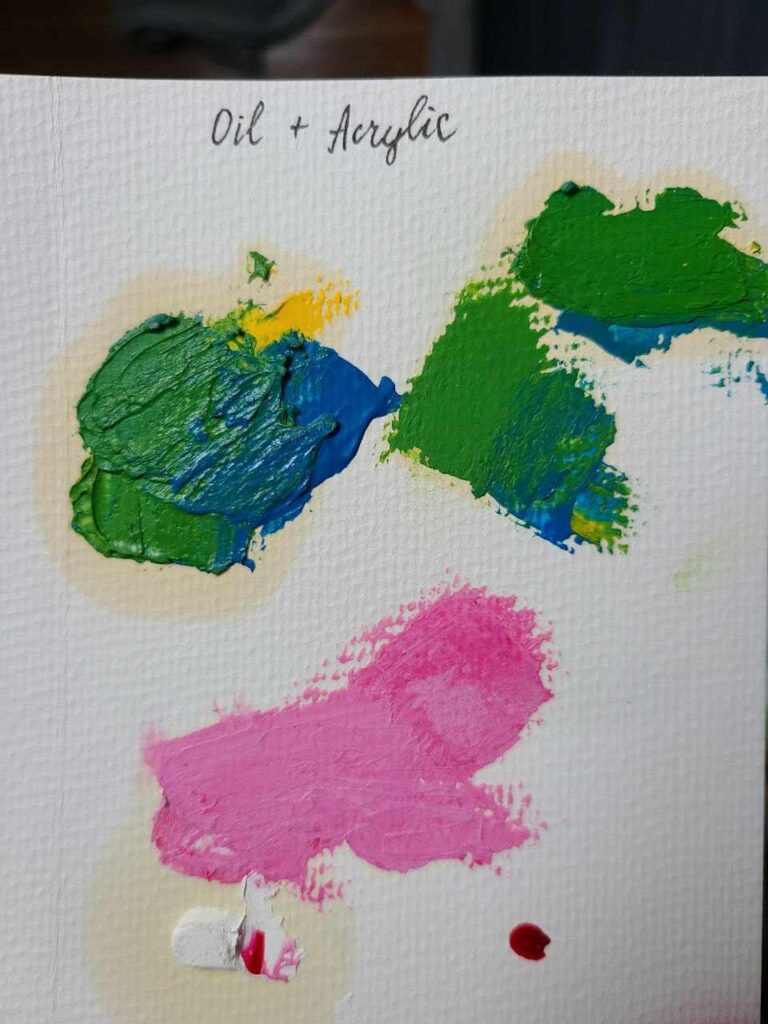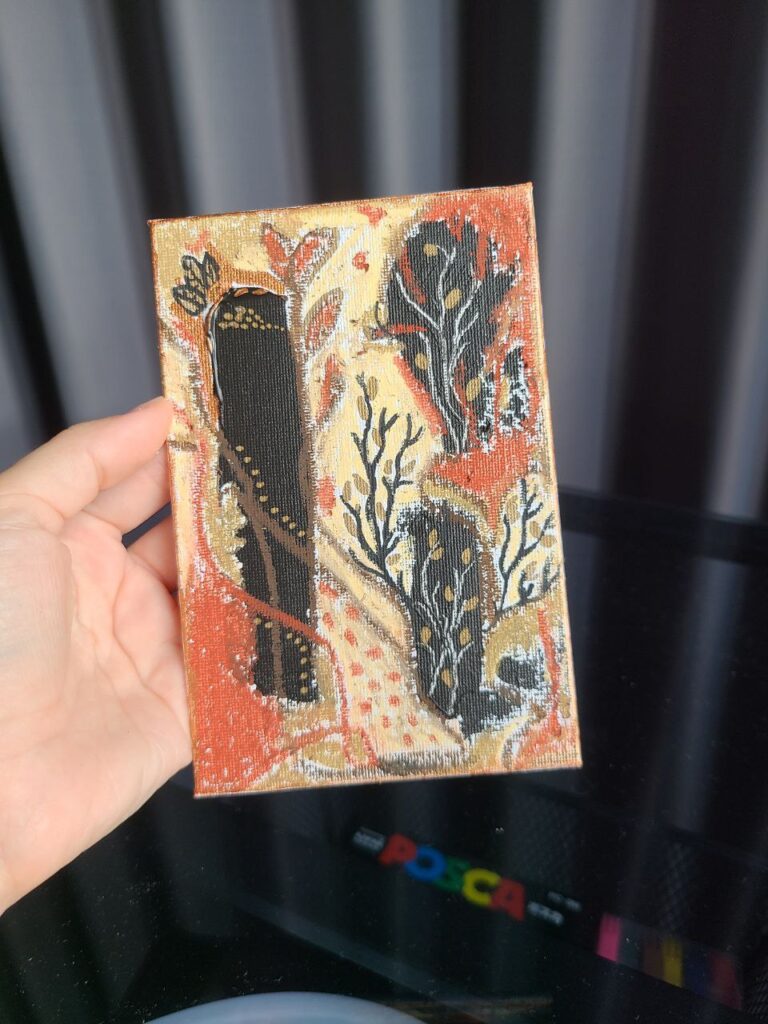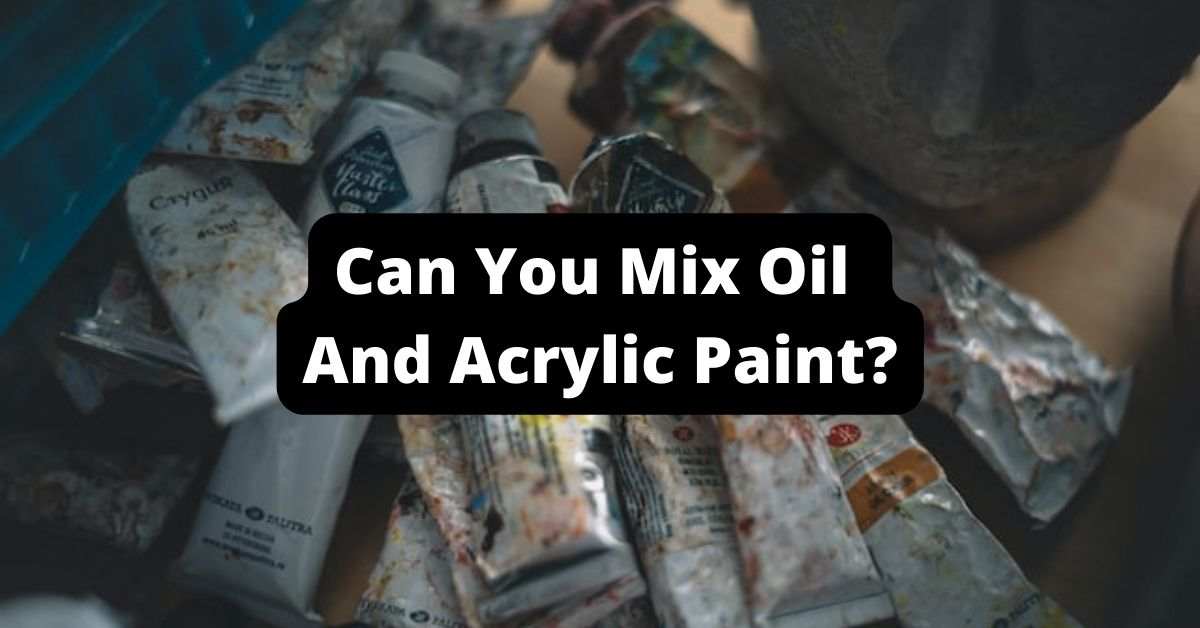Last Updated on March 13, 2024 by Masha Eretnova
When it comes to painting, there’s a decent amount of debate as to whether you should use oil or acrylic paint.
Both have their pros and cons and while both are significantly different, they can be used to produce incredibly similar paintings. So the question “Can I mix oil and acrylic paint?” is legitimate as we want to have the best features of 2 paints.
You cannot mix acrylic paint with oil paint. However, you can use acrylics as nderpainting or base layer for oil painting.
Here’s what you need to know about mixing oil and acrylic paint. I tested it myself and checked on results in 6 months so I have the full picture.

Table of Contents
Can you mix oil and acrylic paint?
You should never mix oil and acrylic paint even though you technically can do it. Although oils and acrylics are the most popular on the market, they are very different.
The bases determine whether you can mix any two paints.
Water mixes with water, oils with oils, etc.
Oil paint is oil-based and acrylic paint is regarded as water-based. If you mix them, the paint will separate because water is denser than oil, forming layers of acrylic and oil paint inside the container.
However, you can potentially mix acrylic with water-based oil paint!
Difference between oil and acrylic paint:
- drying times, acrylic dry in 30 min., oil can take days
- painting techniques
- thinners, and mediums to use, we use solvents like turpentine to prepare oils for painting, but acrylics can be painted directly or thinned with just water. Oil paint cannot be thinned with water.
- texture: acrylic dries to a plastic-y feel and can have texture, but oils are smooth
- adhesion: acrylic cannot stick to oils, but oils can stick to acrylics.
so even if you do mix oil and paint, you won’t be able to achieve your painting goals and the new mix won’t be archival or any durable!
No matter how much you mix or swirl the paints together, oil is hydrophobic, so it won’t dissolve in water.
However, technically, you will be able to mix two paint into one new color, here I did it:
What happens if I accidentally mixed oil and acrylic paint?
If you’re a beginning painter, you may accidentally mix oil and acrylic paint. And visually nothing will seem to be wrong!
So what happens if you accidentally mix oil and acrylic paint?
Oil and acrylic paint won’t fully merge if you mix the two, therefore what you’ll get is a dispersion of the two paints inside a container.
I tried mixing white oil paint with magenta acrylic, and yellow oil with blue acrylic. Both times it took quite a lot of time to really mix it, and it still wasn’t mixed 100%.
The texture and drying time was more close to oil paints. After 24 hrs it was still not fully dried, but already water-resistant.
At the same time, the next mixed color wasn’t durable at all – I could just scrape it with my nail from the paper! It didn’t stick to the surface at all!
The finish was satin and soft to the touch though. Check the video above to see the results.
You may still be able to put it on the canvas. But acrylics dry fast, but oils do not.
Mixing them will result in uneven drying within a layer of paint, and ultimately cracks.
The acrylic paint will flake off since it won’t be able to adhere to the oil paint.
That will be a lesson learned for you, but if you accidentally mix the two, do not panic here’s what you’re going to do:
- If you accidentally mix it on a canvas, just clean the paint away with a paper towel and then wash it with soap and water and dry it.
- If you by accident mixed oil and acrylic in the container, try to thin the paint and see if it will be usable. If not, I’m afraid you will have to discard it.
I mixed oil and acrylics and left the paper for months.
Updated: This is how it looks after a few months: we can see that the binders spread out and stained the paper, looks bad.
It is a good reminder that with paint we have to consider time and how the painting can possibly look over months and years.

Even though while mixing you may think oil paint and acrylic look ok together, think about how it will look over 10 years.
Can you mix oil pastels and acrylic paint in one painting?

Yes, you can use Acrylic paint and standard oil pastels in one mixed-media painting.
For the best effects and to avoid cracking, use oil pastels over the dried acrylic paints if you want to use them together, or use water-soluble oil pastels like crayons and acrylic paint together.
You might try one of the several acrylic paint additives that can change the viscosity, clarity, and handling of the paint while layering oil pastels over acrylic paint.
My fav beginners oil pastels are Haiya Paul Rubens .
Techniques for Using oil and acrylic paint Together
Even though we can’t mix oil and acrylic paint, we can still use them in the same painting.
#1 Oils or Acrylic, Prime the Canvas First
Priming a canvas for oil and acrylic is the same – you should apply a coat or 2 of gesso or buy a pre-primed canvas.
As soon as gesso is dried you can start layering acrylic paint.
#2 Acrylics work as underpainting or base layer for oils
Because acrylics dry so quickly, some artists begin their paintings with acrylics as an underpainting and then finish them in oils.
This techniques saves at least a few days of work with oils, as acrylic underpainting will be dry super fast (max 24 hrs but to touch in an hour) and you can proceed to oil painting.
Also saves money. You can use a cheaper acrylic color for underpainting while oil paints can be much more expensive. Liquitex and Golden are good brands to work together with oils.
#3 DO NOT paint acrylic over oils
Be aware that while acrylic works well as an underpainting for oil paintings, it should never be applied directly over an oil painting. It just won’t stick
Oil paint dries smoothly, but acrylics cannot stick to oily surfaces and might flake away as they dry.
Additionally, oils dry more slowly than acrylics, which may eventually lead the acrylic paint to break and crack.
Oil paint is more flexible than acrylic, so it can be worked on and reworked, which allows one to work on the canvas while a portion is drying.
Acrylic paint dries to a hard finish, and cannot be reworked with water or any medium once dried.
Once the acrylic is dry, you can use oil paints to carefully cover the acrylic paint once it has dried.
Even if you will seal acrylic over oil it won’t be archival and will not last longer than a couple of weeks. Yet, you can also apply an oil-based sealer over acrylics if they are non-yellowing.
#4 Use oils as highlights and accents on acrylic painting
Oil paints’ texture is very buttery, thick and expressive.
They are perfect for addinging finishing touches to a painting that was made with acrylics – for ex., white highlights, textures of trees or grass, clouds, flowers in the background.
Adding oils as the last step will require a longer drying time since oils need a few days up to a month to dry fully before you can varnish.
Read also: Acrylic Painting Techniques For Beginners to Paint like a Pro
#5 Use universal varnish
If your painting has both acrylic and oil paint you need to buy a varnish that works for both. Check the labelsm for ex,m Gamvar is good for both mediums and you can use it.
So If I can’t mix, what should I use, oil or acrylics?
This is a question with no perfect answer.
You can achieve amazing results with both acrylics and oils.
I am impatient, so for me, acrylic paint is the best: easy to mix, apply, clean up, has no odor, and dries in minutes. I used oils too, and loved it, it is a sort of meditation and feels very professional lol 🙂
Acrylic paint is cheaper, I believe, and is more beginner-friendly. I also don’t really like to work with solvent to thin oil as some of them smell strong.
FAQ
Can you mix oil-based paint with water-based paint in general?
As a general rule, any oil is hydrophobic and oil-based paints won’t mix with any water-based paints.
You can, however, use two different mediums in a mixed media painting: water-based paint first, as it needs to adhere well to the canvas, and once it dries, you can paint over a layer of oil-based paint.
Just a quick reminder, water-based paints are: poster paint, tempera, gouache, acrylics, watercolor.
Can you use the same brush for oils and acrylics?
Oil paints work better with natural brushes while acrylics require synthetic bristles. Also oils stick to the brush hair very well and you need to wash them thoroughly before using with acrylics.
I would use separate brushes but if you’re pressed for time, you can share the same brushes.
How do I turn acrylic paint into oil paint?
It’s common knowledge that oil paints blends easier than acrylic.
You can blend them for as long as you like because they dry slowly. It is possible to eliminate all traces of brush strokes.
All these factors make people working with fast-drying acrylics want them to blend as easily as oils.
You cannot change the paint composition, but you can use slow-drying acrylics or mix a retarder into your preferred brand of acrylic paint to blend acrylics like oils and have more working time (up to 1 hour).
Can you mix acrylic paint with other water-based paints?
Yes, acrylic paints are water-based, so you can mix them with other water-based paints like latex paint or watercolors.
Using acrylic and watercolor in one painting, apply acrylic paint over watercolor.
While acrylic paints from various brands can be mixed in theory, the results frequently have an impact beyond the paint’s color.
Keep in mind that each brand may have a distinct composition so you can end up messing with paint ingredients.
A good stir and a test are advised because it wasn’t intended to be used with water-based paint like acrylic.
Can you mix water-based oil and acrylic paint?
Wow! There is water-based oil paint on the market that was designed to be able to mix with water! Yes, you can mix water-based oils and acrylic paints.
If the pigments are compatible, they will react with each other to create a new color.
But the problem may be with drying – oil still tends to dry very slow compared to quick-drying.
Additionally, it’s likely that you’ll combine varying amounts of acrylic and oil paint during the painting. The acrylic and oil paints in the same painting are used in differing amounts and dry at various rates.
Water soluble oil paints can often be blended with either, but you should view this as an experimental technique because they span the gap between oil and acrylic paints.
Wrap Up
Oil and acrylic paint are two different types of paint that serve different purposes. However, following certain techniques you can still successfully use them in the same painting!
Oil paint is known for its ability to create rich, deep colors, while acrylic paint dries quickly and is ideal for painting in layers.
However, If you try to mix the two types of paint together, you will end up with a mess and grainy paint. Layer them but do not mix.
Do you paint with oild and acrylics together? How you go about it?

Masha Eretnova, born in 1991, is a Buenos Aires-based certified teacher, artist, and member of the Professional Artist Association with 20+ years of personal painting journey.
She started painting and drawing very early and is now an international abstract artist and educator passionate about acrylic painting, gouache, and crafts.
Her works are part of international exhibitions and contests, including ArtlyMix (Brazil), Al-Tiba 9 (Spain), Exhibizone (Canada), Italy, and many more.
Besides her artistic pursuits, Masha holds a post-grad diploma in Teaching Film Photography and 2 music school diplomas: piano and opera singing.
